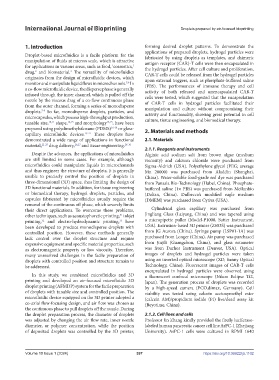Page 405 - IJB-10-1
P. 405
International Journal of Bioprinting Droplets prepared by air-focused bioprinting
1. Introduction forming desired droplet patterns. To demonstrate the
applications of prepared droplets, hydrogel particles were
Droplet-based microfluidics is a facile platform for the fabricated by using droplets as templates, and chimeric
manipulation of fluids at micron scale, which is attractive antigen receptor (CAR)-T cells were then encapsulated in
for applications in various areas, such as food, cosmetics, the hydrogel particles. After cell culture and proliferation,
2
1
drug, and biomaterial. The versatility of microfluidics CAR-T cells could be released from the hydrogel particles
3
4
originates from the design of microfluidic devices, which upon external triggers, such as phosphate-buffered saline
5,6
monitor and manipulate liquid flows in microchannels. In (PBS). The performances of immune therapy and cell
a co-flow microfluidic device, the disperse phase is generally activity of both released and unencapsulated CAR-T
infused through the inner channel, which is pulled off the cells were tested, which suggested that the encapsulation
nozzle by the viscous drag of a co-flow continuous phase of CAR-T cells in hydrogel particles facilitated their
from the outer channel, forming a series of monodisperse manipulation and culture without compromising their
7-9
droplets. So far, monodisperse droplets, particles, and activity and functionality, showing great potential in cell
microcapsules, which possess high-throughput production, culture, tissue engineering, and biomedical therapy.
tunable size, 10,11 shape, 12,13 and morphology 14,15 , have been
prepared using polydimethylsiloxane (PDMS) 16-18 or glass- 2. Materials and methods
capillary microfluidic devices. 19-21 These droplets have
demonstrated a wide range of applications in functional 2.1. Materials
material, 22-25 drug delivery, 26,27 and tissue engineering. 28-30
2.1.1. Reagents and instruments
Despite the advances, the applications of microfluidics Alginic acid sodium salt from brown algae (medium
are still limited in some cases. For example, although viscosity) and calcium chloride were purchased from
microfluidics could manipulate liquids in microchannels Sigma-Aldrich (USA). Polyethylene glycol (PEG; average
and thus engineer the structure of droplets, it is generally Mn 20000) was purchased from Aladdin (Shanghai,
unable to precisely control the position of droplets in China). Water-soluble food-grade red dye was purchased
three-dimensional (3D) space, thus limiting the design of from Panasia Bio-Technology (Hubei, China). Phosphate-
3D functional materials. In addition, for tissue engineering buffered saline (1× PBS) was purchased from Meilunbio
or biomedical therapy, hydrogel droplets, particles, and (Dalian, China). Dulbecco’s modified eagle medium
capsules fabricated by microfluidics usually require the (DMEM) was purchased from Cytiva (USA).
removal of the continuous oil phase, which severely limits
their direct applications. To overcome these problems, Cylindrical glass capillary was purchased from
other techniques, such as acoustophoretic printing, inkjet Jingliang Glass (Laiyang, China) and was tapered using
31
printing, and electro-hydrodynamic printing, have a micropipette puller (Model-P1000, Sutter Instrument,
33
32
been developed to produce monodisperse droplets with USA). Extrusion-based 3D printer (Z603S) was purchased
controlled position. However, these methods generally from JG Aurora (China). Syringe pump (LSP01-1A) was
lack control over the droplet structure and require purchased from Longer (China). Air pump was purchased
expensive equipment and specific material properties, such from Jinjili (Guangzhou, China), and glass rotameter
as electromagnetic property or low viscosity. Therefore, was from Darhor Instrument (Denver, USA). Optical
many unresolved challenges in the facile preparation of images of droplets and hydrogel particles were taken
droplets with controlled position and structure remain to using an inverted optical microscope (XD, Sunny Optical
be addressed. Technology, China). Fluorescent images of CAR-T cells
encapsulated in hydrogel particles were observed using
In this study, we combined microfluidics and 3D a fluorescent confocal microscope (Nikon Eclipse Ti2,
printing and developed an air-focused microfluidic 3D Japan). The generation process of droplets was recorded
droplet printing (AFMDP) system for the facile preparation by a high-speed camera (PCO.dimax, Germany). Cell
of droplets with tunable size and controlled position. The viability was tested using calcein acetoxymethyl ester
microfluidic device equipped on the 3D printer adopted a (calcein AM)/propidium iodide (PI) live/dead assay kit
co-axial flow-focusing design, and air flow was chosen as (Beyotime, China).
the continuous phase to pull droplets off the nozzle. During
the droplet preparation process, the diameter of droplets 2.1.2. Cell lines and cells
was adjusted by changing the air flow rate, inner nozzle Professor Jin Zhang kindly provided the firefly luciferase-
diameter, or polymer concentration, while the position labeled human pancreatic cancer cell line AsPC-1 (Zhejiang
of deposited droplets was controlled by the 3D printer, University). AsPC-1 cells were cultured in RPMI 1640
Volume 10 Issue 1 (2024) 397 https://doi.org/10.36922/ijb.1102

